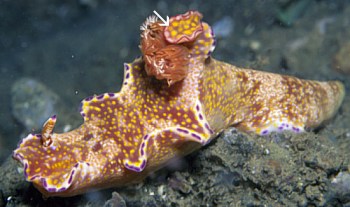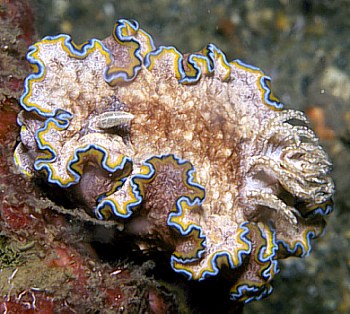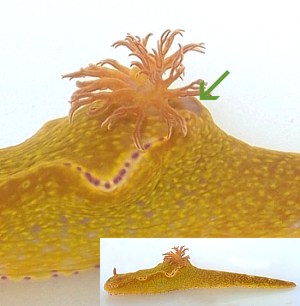Missing in action
June 27, 2000
From: Mary Jane Adams


Dear Bill,
I have several photos in my files of nudibranchs with only one rhinophore and I am very curious about them. Has anyone actually observed fish biting them off? Do they regenerate? I have heard that fish generally avoid eating nudibranchs because they taste very bitter. Is it known if fish can detect the bad taste by smelling them? Could some of the missing rhinophores be the result of developmental a defect? I have no photos of branchs with both rhinophores missing. Could they survive if both were bitten off?
UPPER: Ceratosoma tenue on silty sand, 5 meters deep, Alotau, Papua New Guinea, May 22. 1998
LOWER: Glossodoris cincta in a sandy slope, Normanby Island, Papua New Guinea, May 24, 2000
Thanks!
Mary Jane
mjadams@earthlink.net
Adams, M.J., 2000 (Jun 27) Missing in action. [Message in] Sea Slug Forum. Australian Museum, Sydney. Available from http://www.seaslugforum.net/find/2530
Dear Mary Jane,
When you find an opisthobranch with a bit missing it can have occurred in three ways.
•Injury. This is usually caused by the bite of a predator. Have a look at the Opisthobranch Defence page for some background information. Although many sea slugs have glands and sacs in their skin filled with distasteful chemicals, they only deter predators who know about them. So some sea slugs do get bitten by inexperienced predators. Often the distasteful chemicals cause the predator to spit the slug out, and usually the slugs seem able to withstand quite a bit of damage. In Ceratosoma the dorsal horn (see arrow) contains the distasteful chemicals. It is usually brightly coloured, and I have suggested in the past that it may act as a lure attracting fish to the nastiest part of the body. In the photo alongside is a Ceratosoma tenue from Tanzania with this horn apparently bitten off. The animal was apparently quite healthy, so perhaps it is a useful defence mechanism.
•Autotomy. Some nudibranchs are able to break off sections of their body as a defensive strategy, just like some lizards can lose their tails. each species has a particular 'bit' that is broken off. There are some examples on the Autotomy page.
• Developmental Error. In an earlier message you sent a photo of Chromodoris tinctoria with a funny tube on its mantle. This was clearly a developmental error. I think in both the photos here there is some developmental error as in neither case can I see any sign of the rhinophore pocket into which a 'bitten off' rhinophore normally be able to withdraw. Strangely aberrations with rhinophores seem to occur quite often. Usually it involves fusing of the two, as in Scott Johnson's photo of Gymnodoris ceylonica, but I guess absence is also possible.
Best wishes,
Bill Rudman.
Related messages
-
Chromodoris leopardus with a hood
From: Erwin Koehler, May 18, 2002 -
Damaged Chromodoris tinctoria f rom Malaysia
From: Asther M. Lau, July 9, 2001 -
Chromodoris leopardus freak
From: Mary Jane Adams, January 10, 2001
